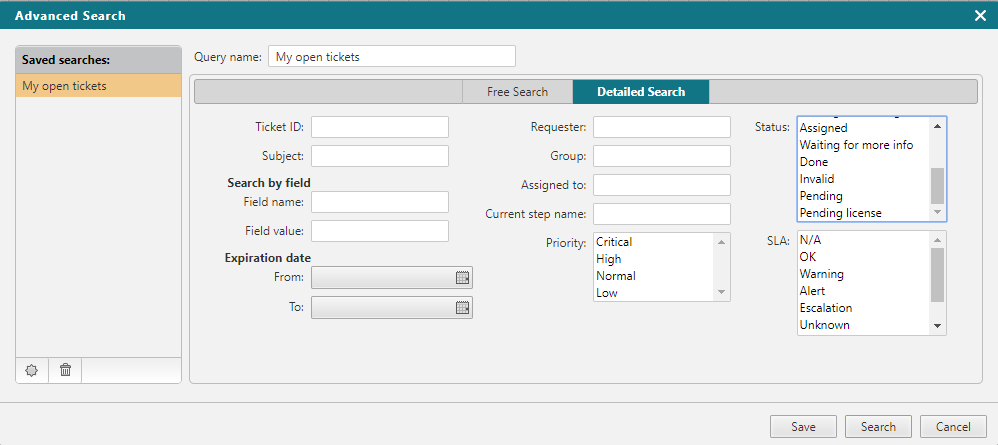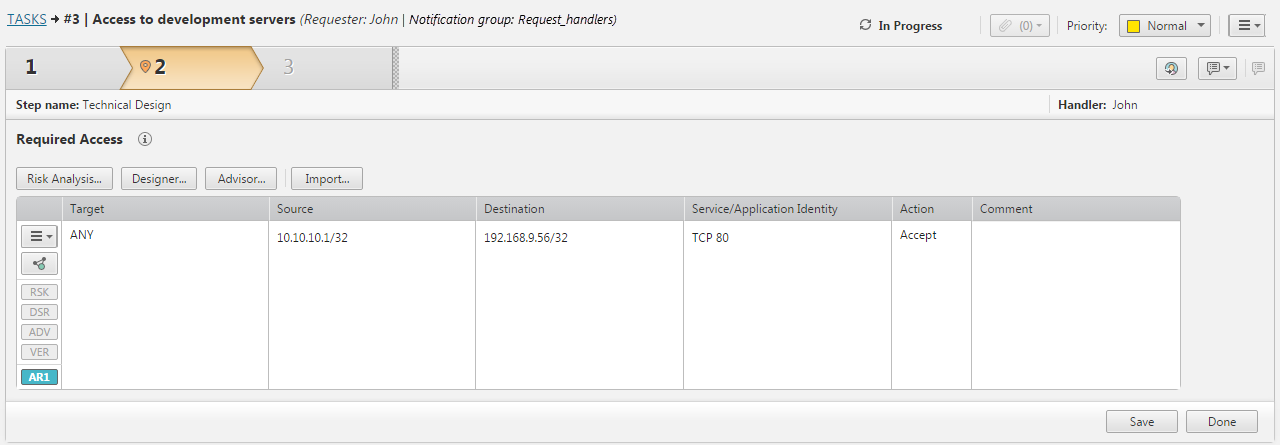On This Page
Searching for Tickets
|
|
This topic is intended for SecureChange handlers who are responsible for processing change requests. |
Overview
Task handlers associated with roles with the View tickets of all users permission can search the ticket database. Other task handlers cannot search for tickets, and instead see a static list of all tickets assigned to them or available to them for self-assignment.
What Can I Do Here?
Searching for Tickets
-
In Tasks, from the View list, select a search:

If the search currently being shown, click the refresh icon
 to update the list.
to update the list.
Configuring a Search for Tickets
- In Tasks, click the search icon

- To edit a search that exists, in the Saved searches list, click on the search.
-
To create a new search:
- Click the new search icon
 .
. -
In Query name text box, enter a name for the new .

- In the bottom left corner, click Save.
- Click the new search icon
-
Select Free Search or Detailed Search.
-
Free search: Search for a phrase in ticket content or field values, including boolean operators and wildcards, according to the Free Search syntax.

-
Detailed Search: Select the search criteria from the search fields.

-
- Click Save.
-
To view the search results, click Search.
The TASKS list shows the search results. From R18-2 HF1, up to 1000 tasks are displayed in the search results. A warning notification is displayed if there are more than 1000 results. Contact Tufin Customer Support to change the maximum number of tasks that can be displayed.
The SLA column indicates the task's progress based on the Service Level Agreement tracking configured in the workflow.

- To sort the tickets, click the relevant column heading.
- Click a ticket to view its details.
Report Search Fields
The following detailed search fields are available:
-
Ticket ID: The ID number that SecureChange assigned the ticket.
-
Subject: A free text search of the subject the requester entered for the ticket. Use quotes to search for the exact ticket name. For example:
"Request access".
-
Field name is the display name of a field configured in the Fields tab of a workflow step.
-
Field value is the value of the field. You can use these operators to build a query: AND, OR (but no more than one use of one of these logical operators), * (wildcard), - (negate), TO (to define a numeric range).
-
Expiration date: When an Expiration date range is specified, only closed tickets are returned.
-
Requester: The user who opened the ticket.
-
Group: The user group that is assigned to this ticket.
-
Assigned to: The user the ticket is currently assigned to.
-
Current step name: The name of a step or task in the workflow that the ticket is at. (For parallel or conditional tasks)
-
Priority: The priority level that the requester assigned to the ticket.
-
Domains: If you enabled Multi-Domain management, you can select the domains to search in.
-
Status: You can select multiple statuses to include in the search.For example, the status “Pending license” lists tickets unable to advance in workflows, until a licensing issue is resolved.
-
SLA: The Service Level Agreement that the ticket is currently in. You can select multiple SLA levels to include in the search.
Priority Icons for SecureChange
The possible SLA tracking statuses are:
|
|
N/A |
SLA was not configured for the workflow |
|
|
1 gray square |
OK |
|
|
2 gray squares |
Warning |
|
|
3 red squares |
Alert |
|
|
4 red squares |
Escalation |
You can hover over the SLA tracking icon to see a description of the status.
Ticket View
Once you have located a ticket and selected it, its details appear. From this view, depending on your permissions, you manage the ticket as it moves from step to step in the workflow.

